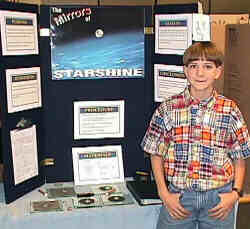Here is an excellent science fair project that was done in early 2000 by Phoy St. John, a freshman at Sandia High School in Albuquerque, NM. Phoy studied how solar activity impacts the earth's atmosphere and thus the lifetime of low-earth-orbiting satellites. When radiation from solar storms reaches the earth, the upper atmosphere expands. The expanding atmosphere increases the drag on satellites, causing a decay in their orbits. By observing the orbital decay of Starshine, Phoy was able to measure fluctuations in the atmosphere's density at high altitudes. His project was awarded second place in the physical science division of the New Mexico State Science Fair. He is now extending his studies to include the effect of solar extreme ultraviolet (EUV) on the atmosphere, at the suggestion of Dr. Judith Lean of the U.S. Naval Research Laboratory.

